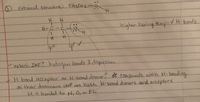
Chemistry
10th Edition
ISBN: 9781305957404
Author: Steven S. Zumdahl, Susan A. Zumdahl, Donald J. DeCoste
Publisher: Cengage Learning
expand_more
expand_more
format_list_bulleted
Concept explainers
Question
thumb_up100%
The instructions are to select all choices that are true about ethanol. I think all are true except for A. I dont know how to figure out about head to head overlap. Can someone explain how to determine if thats true or false?

Transcribed Image Text:O Every bond in ethanol is made by head-on or head-to-head orbital overlap.
O Ethanol is expected to boil at relatively higher temperature.
O Every carbon atom in ethanol is sp hybridized.
O Ethanol is both H-bond acceptor and H-bond donor.
O Ethanol molecules interact with each other by dispersion forces.

Transcribed Image Text:Sthanal structure: CH3CH20
H.
1.
H-C-C
higher bailing emp-
V H-bonds
H.
H.
wwhich IMF? hydrogen bonds 8 dispersion
H bond acceptor or H-bond donor A compounds wiNh H-bonding
os their dominant IME are both H-bond donors and acceptors
Habonded to N, O, or FL
:0:
Expert Solution
This question has been solved!
Explore an expertly crafted, step-by-step solution for a thorough understanding of key concepts.
This is a popular solution
Trending nowThis is a popular solution!
Step by stepSolved in 2 steps with 1 images

Knowledge Booster
Learn more about
Need a deep-dive on the concept behind this application? Look no further. Learn more about this topic, chemistry and related others by exploring similar questions and additional content below.Similar questions
- Match the hybridized and atomic orbitals to the appropriate labels. Drag-and-drop each label to the appropriate target, each answer choice can only be used once. C 5p3 B sp³d D sp F sp³2arrow_forwardWhich of these molecules is expected to have the strongest molecular dipole. BF3, PF3, OCI2 none of them are the strongest all of them are the strongest PF3 carbon OCI2 BF3arrow_forwardChoose the Newman projection that best represents the wedge-dash structure. CI. H CH3 CH3 H CI H3C 4 IV II CI H3C H H₂C CI- HH CH3 H CH3 H CI CI CH3 -CI E H H. CI H₂C CH₂ H H CH3 -CI CI CI CH3arrow_forward
- Please confirm if my answer is correct or not. Due to the need for this to be correct I would like you to provide me with a confidence score in you answer on a scale from 1 to 10 how confident are you in your answer. Please be sure to double check your answerarrow_forwardWe don't see the answer written with a photo or pen, give the answer using the toolarrow_forwardConstruct the HCHO molecule in MolView and select the most accurate value of the H-C-H bond angle below. 109.5° 90° 120° 180°arrow_forward
- Please answer 3 & 4arrow_forward4) a) Draw the p-orbitals that are involved in the pi-system in molecule 1 shown below. Make sure to include shading and put any lone pairs that are in a p-orbital in one in your drawing. H₂N Carbon 3 Carbon 2 1 H3CO Carbon 1 b) Are the p-orbitals on carbon 1 and carbon 2 in molecule 1 in conjugation with each other? (ie are the p- orbitals pointing in the same direction). Explain your reasoning.arrow_forwardTypes AX4E (seesaw), AX3E2 (T-shaped), and AX2E3 (linear) In PCl4–, the lone pair of electrons can be placed in either an equatorial or an axial position. Determine the total number of each type of 90° repulsive interactions for each placement.arrow_forward
arrow_back_ios
arrow_forward_ios
Recommended textbooks for you
 ChemistryChemistryISBN:9781305957404Author:Steven S. Zumdahl, Susan A. Zumdahl, Donald J. DeCostePublisher:Cengage Learning
ChemistryChemistryISBN:9781305957404Author:Steven S. Zumdahl, Susan A. Zumdahl, Donald J. DeCostePublisher:Cengage Learning ChemistryChemistryISBN:9781259911156Author:Raymond Chang Dr., Jason Overby ProfessorPublisher:McGraw-Hill Education
ChemistryChemistryISBN:9781259911156Author:Raymond Chang Dr., Jason Overby ProfessorPublisher:McGraw-Hill Education Principles of Instrumental AnalysisChemistryISBN:9781305577213Author:Douglas A. Skoog, F. James Holler, Stanley R. CrouchPublisher:Cengage Learning
Principles of Instrumental AnalysisChemistryISBN:9781305577213Author:Douglas A. Skoog, F. James Holler, Stanley R. CrouchPublisher:Cengage Learning Organic ChemistryChemistryISBN:9780078021558Author:Janice Gorzynski Smith Dr.Publisher:McGraw-Hill Education
Organic ChemistryChemistryISBN:9780078021558Author:Janice Gorzynski Smith Dr.Publisher:McGraw-Hill Education Chemistry: Principles and ReactionsChemistryISBN:9781305079373Author:William L. Masterton, Cecile N. HurleyPublisher:Cengage Learning
Chemistry: Principles and ReactionsChemistryISBN:9781305079373Author:William L. Masterton, Cecile N. HurleyPublisher:Cengage Learning Elementary Principles of Chemical Processes, Bind...ChemistryISBN:9781118431221Author:Richard M. Felder, Ronald W. Rousseau, Lisa G. BullardPublisher:WILEY
Elementary Principles of Chemical Processes, Bind...ChemistryISBN:9781118431221Author:Richard M. Felder, Ronald W. Rousseau, Lisa G. BullardPublisher:WILEY

Chemistry
Chemistry
ISBN:9781305957404
Author:Steven S. Zumdahl, Susan A. Zumdahl, Donald J. DeCoste
Publisher:Cengage Learning

Chemistry
Chemistry
ISBN:9781259911156
Author:Raymond Chang Dr., Jason Overby Professor
Publisher:McGraw-Hill Education

Principles of Instrumental Analysis
Chemistry
ISBN:9781305577213
Author:Douglas A. Skoog, F. James Holler, Stanley R. Crouch
Publisher:Cengage Learning

Organic Chemistry
Chemistry
ISBN:9780078021558
Author:Janice Gorzynski Smith Dr.
Publisher:McGraw-Hill Education

Chemistry: Principles and Reactions
Chemistry
ISBN:9781305079373
Author:William L. Masterton, Cecile N. Hurley
Publisher:Cengage Learning

Elementary Principles of Chemical Processes, Bind...
Chemistry
ISBN:9781118431221
Author:Richard M. Felder, Ronald W. Rousseau, Lisa G. Bullard
Publisher:WILEY